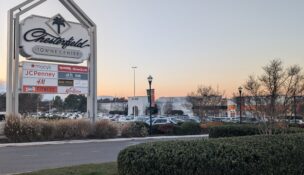Creating relationships
CoStar CEO wants to recruit and retain real estate researchers
Creating relationships
CoStar CEO wants to recruit and retain real estate researchers
Andrew Florance was faced with a choice as he was finishing his undergraduate degree at Princeton University 30 years ago. He could go on to graduate school or he could pursue his dream of using new technology to create a commercial real estate research company.
Florance had hatched that business plan while working as a summer intern with a Washington, D.C., real estate firm. He watched as company employees made financial projections on a new office building in pencil on a 24-by-18-inch spreadsheet. Why, he wondered, didn’t they take advantage of personal computers, which had recently appeared on the market?
“That was a real eye-opener. I knew that people were leasing real estate, buying and selling and valuing real estate, all by manual processes,” Florance says. “I thought that was a huge opportunity. I actually started working out of my college dorm my senior year, writing software to basically manage [real estate] information.”
But a real estate professor Florance consulted didn’t think much of his idea of starting a research company, urging him to go to graduate school and become a developer. Florance ignored that advice and started CoStar Group Inc.
Now, that professor’s son manages an investment fund that is one of CoStar’s major investors. “I love the fact that this professor who said I’ve got the stupidest idea in the world has a son who is a fund manager with $400 million of our stock,” Florance says.
Forbes magazine has called Washington, D.C.-based CoStar one of the “100 Most Innovative Growth Companies.” Fortune magazine identified it as one of the nation’s “100 Fastest Growing Companies.”
Soon, CoStar will become a major employer in Richmond. In late October, the company announced it will spend $8.2 million to establish a 125,000-square-foot research operations headquarters in four floors of a nine-story building on the banks of the James River.
CoStar eventually will employ about 730 people in the building, which it will share with WestRock Co., a packaging company formed in the 2015 merger of Richmond-based MeadWestvaco and Georgia-based Rock-Tenn Co. The CoStar project is expected to pump $250 million into the Richmond regional economy.
CoStar currently employs about 3,300 people worldwide. Customers use its data to buy or lease real estate or find information about office, industrial and retail properties. The company, which also owns the apartment listing website Apartments.com, generated revenue of $711.8 million in 2015.
CoStar picked Richmond for the research center after a yearlong search involving 20 cities around the country. Kansas City, Mo., and Charlotte, N.C., were the other finalists.
Important factors in the decision were the area’s cost of living, quality of life and the proximity of a number of universities. The company seeks a highly educated workforce, and it hopes to work with schools as research partners.
Most of all, Florance wants Richmond employees to stay with the company, establishing long-term relationships with its customers. “Our clients feel like they invest in our researchers,” he says.
In addition to guiding CoStar, Florance serves on the board of directors of the American Real Estate Society and Walker & Dunlop Inc., one of the largest commercial real estate finance companies in the U.S. The Office of the Mayor in the District of Columbia recently named him to a task force reviewing D.C.’s use of real estate.
Virginia Business editors Robert Powell and Paula Squires interviewed Florance at its offices in October. The following is an edited transcript.
VB: How has your company changed the real estate industry?
Florance: I’ve been spending a little bit of time in Madrid lately, and we’re beginning to ramp up there. Madrid reminds me of Washington, D.C., in 1988 or ’89 in terms of the way information flows … Madrid is the exact same size as Houston, Atlanta and Washington in terms of GDP or in terms of population. In Madrid, the top 20 brokerage firms have 500 brokers total, as opposed to Houston, Washington and Atlanta having 1,500 [each]. Then the amount of inventory that the top brokerage firms have to move in Madrid is 25 million feet. In Washington, Atlanta and Houston it’s 100 million feet. The brokers themselves are earning 300 percent more in Washington, Atlanta and Houston on average than they are in Madrid … They earn more in an information-rich environment than they do in an information-starved, nondigital environment.
VB: What made you decide to create this research operations headquarters and why did you decide not to base it in D.C.?
Florance: [While CoStar relies on sophisticated technology], at the end of the day, it’s about people who are communicating with the owners, developers and brokers. They are a trusted intermediary or curator of the information … Our clients love to develop long-term relationships with our researchers … The longevity of those relationships is important.
We need to have college-educated, sharp, motivated people with good relationship skills. [The decision on locating the center was] about creating the best environment for them. In Washington, if I want to be able to walk 10 minutes to work, I would have to spend $2,300 a month for an apartment. If I do the same thing in Richmond, I could spend $1,000 a month. For someone coming out of college with a little bit of student debt, a $15,000 to $16,000 differential is huge. Another important thing to a 29-year-old would be the cost of a pint of beer …
We also want to invest in [employees’] education. We bring professors in, and we actually fund graduate education for them. We like an environment where you have a bunch of great educational institutions. [Here you have] Virginia State, VCU, Virginia Union, University of Richmond, U.Va., Virginia Tech, I mean, a phenomenal educational system — and affordable beer.
VB: You probably are aware that there’s been an advanced manufacturing collaborative research center south of here [the Commonwealth Center for Advance Manufacturing in Prince George County].
Florance: That’s sort of the model we’d love to pursue. How can you take this sort of content and apply it in a real-world scenario? We’ve got 25 million people a month coming to our websites and they’re conducting a billion searches a year and you’ve got a trillion data points coming back, and we’re saving every bit of it … Historically, you’d learn in real estate 101, that you look at a building and you look for other buildings of the same type within a couple blocks, and those are your peers. Except now we know those are not the competitors. What’s more of an indication of a competitor is what the consumer looks at and shops for. We can say that a hundred million renters came and searched, and the ones that looked at these lofts in this community most likely spent the same amount of time looking at [loft apartments] three miles away, down the river. So your competitor is not that building two blocks away. Your competitor is three miles away, down the river.
We now even have data where, we frankly can see how inefficient people are at pricing their real estate. You’ll see one community setting a price just $100 too high a month, and they will get only 10 percent of the attention of the renters that another community priced $100 dollars lower gets. You realize that the automated pricing systems have to move out to the internet where the consumer is actually searching. As real estate becomes completely digital, that will keep the academic world busy for a long, long time, and the more problems the academic world can dig into, the more the private sector can consume that knowledge.
VB: Where does most of your information come from, public data or private sources?
Florance: There are probably several hundred different sources of data. One of the keys to presenting good data is having the software to pull together all those different flows of data and rationalizing and curating it into something that makes sense … There will be a lot of data coming from public data sources: the Department of Energy, the EPA, the SCC, state insurance filings. There will be tons of private sources of data coming in …
Then we write tens of thousands of little software robots that roam around the internet collecting data. We have a robot that puts in every single possible permutation of potential deed number every morning and compares it to what was there yesterday morning and then finds the new deed. So we can actually get immediate word of a new deed through this sort of code cracking. We also have robots that [track the locations of CVS drugstores]. If we find there’s a new CVS, we then send a trigger to our researchers responsible for that neighborhood who will then figure out what happened — like who built it and what was there before …
We will have a point person who manages a relationship here in Richmond between CoStar and the brokers at [major brokerages] or at any of the big developers. We take all that data, and we try to make sure that the most important part of the market, which is the active listings, are being accurately represented and the deals are being accurately represented. At any point, there’s more than a trillion dollars of potential transactions being offered to the market here in the United States, and our brokerage clients earn about $60 billion of commissions off that each year.
VB: How well did you know Richmond before you started this search?
Florance: I personally worked with the brokerage firms here 15 to 20 years ago in getting CoStar going. When I first started up the company, my sister had a little graphics shop down here, and I would spend every week here when we were producing our first product. When we printed commercial real estate directories back in the early ’90s, we used to print those down here in Richmond. I’ve gone up and down I-95 a fair amount.
VB: Now, tell me a little bit of where your revenue comes from.
Florance: [CoStar] subscribers pay a monthly subscription fee, roughly a per- broker subscription fee. Institutions pay a similar sort of fee. We have a quarter million clients, and, they include every major brokerage firm in the United States. Most of the vast majority of the substantial [real estate owners] are using it. A vast majority of banks use it, also regulators and economic development, state government and federal government [officials].
On the apartment side and on the commercial real estate side, people pay advertising fees to generate leads online. We’ve served up 50 million leads for tenants to our clients over the past two years. We believe we’re involved in about 85 percent of all real estate deals in the United States.
We do a lot of other things, like things you’d never think of. We’re the number one site for buying and selling farms in the United States, which is a multitrillion-dollar sector. That’s timber, that’s minerals, that’s agriculture. And we’re also the number one website for buying and selling small businesses … Then we also do things like rent payment systems
… We do econometric consulting and then we also have a team that works with the Fed and various major banks on doing debt risk analytics … We’re involved in a lot of stuff.
t
















